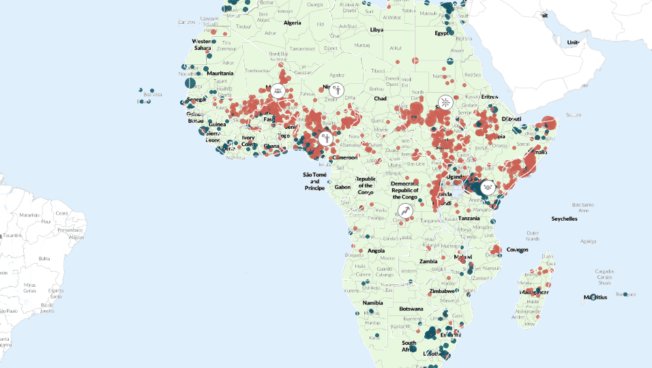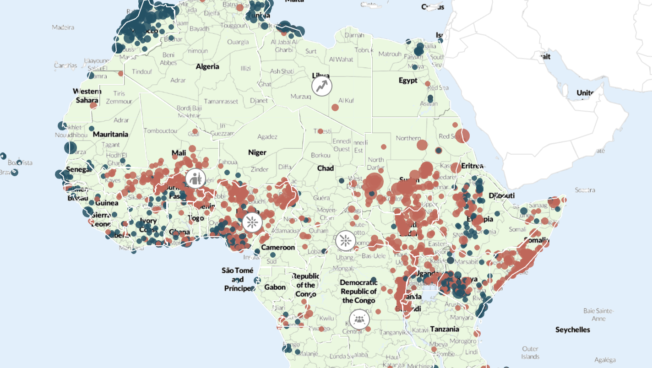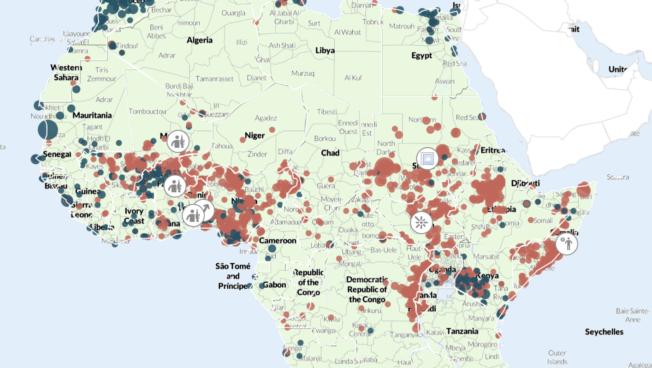Regional Overview
Africa
May 2025
Posted: 9 May 2025
In this Regional Overview covering April 2025
- Benin: JNIM offensive drives a surge in violence to record levels
- Burkina Faso and Mali: JNIM sustains offensives with mass casualty attacks and drone strikes
- Somalia: Increasingly fatal battles take place in Hirshabelle
- South Sudan: Battles escalate amid President Kiir’s political reshuffling
- Sudan: No relief for civilians despite violence dropping to the lowest level since the war began
- Togo: JNIM militants launch the first insurgent drone attack in Savanes
Benin: JNIM offensive drives a surge in violence to record levels
Violence in northern Benin reached a new milestone when al-Qaeda-affiliated Jama’at Nusrat al-Islam wal-Muslimin (JNIM) fighters carried out a major double attack on 17 April. The coordinated assault targeted military positions at Point Triple and Chutes de Koudou in the W National Park, killing at least 54 Beninese soldiers,124 Heures au Benin, “54 soldiers killed at the front according to the government,” 23 April 2025 (French)
JNIM claimed responsibility for the double attack and said its fighters killed 70 soldiers. The group diffused videos from the attack on social media that displayed a large amount of captured weapons, ammunition, and equipment. Chirpwire @AzZallaqa, 17 April 2025; X @SimNasr, 19 April 2025; X @SimNasr, 26 April 2025 making it the deadliest single day of conflict since militant activity began spreading into Benin in 2019. The escalation reflects JNIM’s entrenched presence along the Burkina Faso-Benin border, particularly in the Tapoa and Kompienga provinces, which serve as staging grounds for incursions into Beninese territory. The group has also expanded its use of the W-Arly-Pendjari Complex and surrounding areas, using the terrain to support its movements and operations.
April’s events follow a similar deadly incident carried out by JNIM in January 2025 that left at least 34 soldiers dead in the same area. With at least 88 military personnel killed in just four months, the first quarter of 2025 has already surpassed the total number of reported deaths recorded in 2024. The scale and frequency of attacks suggest that Benin is increasingly exposed to the same insurgent dynamics seen in the central Sahel. It shares the burden with Togo, which is also affected by the ongoing regionalization of the Sahel crisis.
Burkina Faso and Mali: JNIM sustains offensives with mass casualty attacks and drone strikes
Despite a relative decrease in reported events and fatalities across Burkina Faso and Mali in April, JNIM has maintained its high operational tempo through ongoing offensives. The group continued to sustain pressure on military forces and administrative centers in both countries, totaling about two dozen high-fatality attacks this month in which 10 or more people were killed. Overall, reported deaths from JNIM activity increased from 502 in March to 512 in April in Burkina Faso and from 180 to 207 in Mali.
In Burkina Faso, JNIM militants carried out coordinated attacks on military and Volunteers for the Defense of the Homeland (VDP) positions in several regions, including Boucle du Mouhoun, Cascades, Center-East, Center-North, East, Hauts-Bassins, North, and Sahel. A major JNIM offensive took place in Guiedougou, Di, and Lanfiera, in the Boucle du Mouhoun region, resulting in a series of mass atrocities in which at least 100 civilians were killed and dozens abducted after attempts were made to recruit residents to the VDP. The group also used drone-delivered explosives in Burkina Faso’s Nord and East regions, respectively targeting military and VDP positions without causing any damage or casualties. However, a drone attack in Dogofri in Mali’s Segou region resulted in one Dozo militia member being killed and about 10 others being wounded.
In Mali, JNIM attacked police, gendarmerie, and military positions in Kayes, Koulikoro, Mopti, Segou, and Sikasso. Koulikoro became a flashpoint of violence after JNIM militants and the Malian military (FAMa) clashed near the town of Nara, resulting in the reported death of 28 FAMa soldiers. FAMa and Wagner forces then launched a counter-offensive in the nearby areas of Sebabougou and Kwala, killing dozens of JNIM militants and civilians.
Somalia: Increasingly fatal battles take place in Hirshabelle
In Hirshabelle state, al-Shabaab led a deadly offensive against military forces and allied armed groups to regain previously held territory that had been under the control of Somali government forces since 2022. Al-Shabaab militants clashed with the Somali National Army (SNA) and allied militias across both Hirshabelle’s Middle Shabelle and Hiraan regions, briefly occupying areas with large SNA bases, including Wargaadhi and Adan Yabaal towns in Middle Shabelle.2Mohamed Dhaysane, “Al-Shabaab terrorists attack strategic army base in Somalia, multiple casualties on both sides,” Anadolu Agency, 24 April 2025; Wycliffe Muia, “US-Somali airstrike as battle rages for key town,” BBC, 17 April 2025 While clashes in Hirshabelle have raged since the start of the year, they turned increasingly fatal in April compared to March. ACLED records over 380 fatalities from battles in Hirshabelle state last month, rising 25% from the previous month. The al-Shabaab offensive in Hirshabelle state has raised increasing concerns over the group’s capacity to capture areas near the federal capital of Mogadishu, as the militants fired mortar shells near the Aden Adde International Airport.3Abdi Sheikh, “Al Shabaab attacks strategic Somalia town as it presses offensive,” Reuters, 16 April 2025
The clashes are part of an offensive al-Shabaab launched in central Somalia in February, likely aimed at exploiting security gaps left by the reduction in African Union peacekeeping troops.4Al Jazeera, “Al-Shabab battles Somalia’s army for strategic military base,” 24 April 2025 Despite calls by some AU troop-contributing countries to the Somalia mission for an additional 8,000 troops, the AU faces potential withdrawal of the Burundian contingent and funding shortages from the United States and European Union.5The Defense Post, “AU Somalia Mission Says Needs 8,000 More Peacekeepers,” 26 April 2025; Somali Guardian, “AUSSOM troop-contributing countries urge deployment of additional 8K forces to Somalia,” 26 April 2025 The SNA is increasingly overstretched fighting militants on several fronts, forcing Mogadishu to turn to Turkey for military support. On 22 April, an agreement signed between Turkey and Somalia in 2024 was made public, revealing how Ankara secured major financial and strategic concessions in exchange for an energy and defense partnership.6Sheriff Bojang Jnr, “Why Somalia’s oil deal with Turkiye is facing growing backlash,” The Africa Report, 24 April 2025
South Sudan: Battles escalate amid President Kiir’s political reshuffling
The rift between President Salva Kiir and First Vice President Riek Machar deepened last month, as Kiir made sweeping changes to the government in April and into early May. Some of the changes to government positions drew scrutiny for what was considered a violation of the 2018 peace agreement, including the appointment of South Sudan People’s Defence Forces (SSPDF) generals to commissioner positions in Ulang and Nasir counties.7Radio Tamazuj, “Kiir replaces general intelligence chief, security advisor,” 30 April 2025; Radio Tamazuj, “Kiir reshuffles Upper Nile, C. Equatoria, and Warrap state governments,” 6 May 2025 The political upheaval drove a 25% increase in battles in April compared to the previous month, with ACLED recording more than 75 such events. Military forces under Kiir’s control increasingly clashed with numerous Nuer-dominated militias under the Sudan People’s Liberation Movement-In Opposition (SPLM-IO) and White Army in April, after the government accused the White Army of having links with Machar.8George Obulutsa and Hereward Holland, “South Sudan detains oil minister and military officials in threat to peace deal,” Reuters, 7 March 2025 SSPDF and allied militias eventually regained control over Nasir and Ulang towns from the White Army. Most clashes occurred in Jonglei and Upper Nile states in the restive Greater Upper Nile region — an area of ongoing unrest that comprised nearly half of all communal violence in 2024.
Sudan: No relief for civilians despite violence dropping to the lowest level since the war began
After the Sudanese Armed Forces (SAF) regained control of Khartoum in March, political violence across Sudan dropped to its lowest levels in April since the war began two years ago. Violent events in Khartoum state nearly halved last month compared to March, as the limited ongoing contestation between the SAF and the Rapid Support Forces (RSF) primarily shifted to Omdurman and sporadic clashes further outside the city on the west sides of the Nile. Despite the overall fall in violence, civilians continued to face elevated risks in the capital. Amid the diminished contestation, the SAF carried out a string of deadly attacks on suspected RSF supporters as the military moved to regain control of the city, reportedly killing over 100 people.
Following the defeat in Khartoum, the RSF shifted its attention to securing North Darfur and aimed to complete a year-long campaign to secure the capital of El Fasher, the SAF’s last remaining stronghold in Darfur. The RSF conducted deadly ground and aerial offensives in El Fasher, yet nearly half of the violence solely targeted civilians. Displaced people in camps around al-Fasher were particularly targeted by the RSF. Hundreds of thousands of people were displaced across North Darfur due to the ongoing violence.9Al Jazeera, “More than 480 civilians killed in Sudan’s North Darfur over two weeks: UN,” 25 April 2025 The RSF offensive resulted in the deadliest month of violence in North Darfur since the war began in April 2023, with ACLED data recording over 1,300 reported fatalities in April alone.
Togo: JNIM militants launch the first insurgent drone attack in Savanes
In Togo, JNIM militants are suspected of having launched the first suicide drone attack on a Togolese military position in Djignandjoaga on 9 April. The attack comes amid a wider push by JNIM fighters to deploy more sophisticated tactics in Coastal West Africa since late 2024. Particularly in Togo, the group has expanded its operations from traditional raids and IED ambushes to include the use of rockets, directed explosive charges, and drones to attack military camps, convoys, and patrols. The rapid spread of JNIM’s drone warfare tactics underscores the group’s expanding operational reach, tactical innovation, and strategic intent in the littoral states of West Africa. It also demonstrates how well JNIM is monitoring and coordinating its operations outside its traditional strongholds in the Sahel and underscores the evolving and persistent threat that prompted Togo’s decision to extend its state of emergency for another year in March.
At the same time, the increasing sophistication of JNIM’s methods follows a broader trend in the Sahel, where non-state armed groups have begun using drones in combat. JNIM is the most prolific actor in this regard and has carried out more than a dozen drone attacks using IEDs since its first attempted drone strike in Mali in September 2023. In Burkina Faso, JNIM has also increasingly used drones to attack soldiers, VDP, and civilian gatherings. In doing so, it combines guerrilla tactics with aerial capabilities to adapt to the changing conflict dynamics and continued expansion.
See More
See the Codebook and the User Guide for an overview of ACLED’s core methodology. For additional documentation, check the Knowledge Base. Region-specific methodology briefs can be accessed below.
Links:
For additional resources and in-depth updates on the latest political violence and protest trends, check our local observatories for Mozambique and Ethiopia, as well as our special Nigeria Election Violence Tracker project.







